Every year, my husband and I make a bet as to which duck will be the first to arrive on Lake Merritt during fall migration. This year, I lost. Not only did I lose, I did so spectacularly, as my pick, the Canvasback, was the last to arrive in any significant number. Now, before any experienced birders chide me for such hopeless speculation, let’s have some background information on our lake’s array of waterfowl.
Lake Merritt is home to the nation’s oldest wildlife sanctuary, established in 1870. In addition to protecting citizens from stray birdshot, the refuge greatly benefited the Snowy Egret, whose white plumes were prized at the time as decoration for ladies’ hats.
Over a century later, both Snowies and their larger relative, the Common Egret, now thrive year-round on the lake, along with other nesting residents such as the Double-Crested Cormorant, the Black-Crowned Night Heron, and the elusive Great Blue Heron. We won’t discuss the geese (or their byproducts).
From April through September, the only ducks typically seen on the lake are Mallards. Since they nest here, you can usually spot one or two or broods of ducklings each spring.
As winter settles over Alaska and Canada, many northern birds migrate to milder southern climates. Bay area residents are lucky to be situated along the Pacific flyway, which brings many different species through the region. Vast numbers of ducks, geese, and swans flock to flooded farmlands up near Sacramento and in the central valley, while smaller clusters settle on the coast in hospitable environments such as ours.
Migrants begin arriving in our neighborhood as early as September, though ducks generally hold off ‘til October and don’t reach full numbers until mid-November. Some years, they plop down en masse, as though a bird-bus pulled into the station overnight. In other seasons, such as this one, the waterfowl trickle in slowly.
The best place to find ducks is near the five “bird islands” by the Rotary Nature Center, where all species discussed below can be seen. The best time for viewing on that side of the lake is either early or late in the day to avoid the glaring midday sun.
Often, the first out-of-towner to land is the American Coot. That’s the goofy black bird that looks like a chicken. Both males and females are black, with a white bill. Though not a duck, its arrival heralds the start of the season. Coots are noisy and argumentative. Their most interesting feature is usually hidden underwater; they have wonderful feet that resemble ferns. The best time to see coot feet is on a clear-water day, or when the birds are on land. Coots can be seen all around the lake, so just find one paddling near the embankment and take a gander.
Odds are even that the Ruddy Duck will beat its brethren to Lake Merritt in fall. Ruddies are very small and are frequently spotted in fleets near the El Embarcadero pergola. Even in bad light, they can be identified by their upright tails, held aloft like little flags. Both males and females are brown, but the fellas have a full white cheek. Keep an eye on these guys in spring; in mating mode, they turn their namesake sienna hue and their bills become turquoise.
Also congregating in large numbers are Scaups. There are two varieties, the Lesser Scaup and the Greater Scaup. It took us two years to tell them apart, so don’t worry if you can’t. Basically, male Scaups have black heads and tails, with a gray midsection. There are usually great numbers of Scaup within the restricted area of the lake, so they’re hard to miss. If you happen to be at the Nature Center when someone is feeding the waterfowl, Scaups will come in droves. If you’re lucky, you’ll see a single Ring-Necked Duck (sometimes called a Ring-Necked Scaup). We’ve already confirmed his return this year.
Like most female ducks, the Scaup gals are brown. Novice birdwatchers will have an easier time identifying species by the males. Once you’ve become familiar with enough birds, you’ll be able to spot drakes and hens separately.
One of the easiest visitors to identify is the Bufflehead, North America’s smallest diving duck. Males are bright white on the bottom and black on the top, with a signature wedge of white on the crest of their head. From afar, they resemble tiny sailboats on the lake. Buffleheads are very active. Rarely will you catch them snoozing or resting; they seem always to be diving for food or, on occasion, preening and bathing(they’re pretty cute when they do, too). Unlike most Lake Merritt ducks, Buffleheads shy away from people. Subsisting primarily on mollusks, crustaceans, and fish, they don’t have much interest in handouts, and their cautious nature usually sends them swimming away when humans approach.
Not to be confused with their Bufflehead cousins, Goldeneyes are also black and white, though larger and mottled. While Buffles have a sleek, simple pattern, Goldeneyes sport either stripes or spots along their side and a white spot on the cheek. There are two types of Goldeneye on Lake Merritt; like Scaups, they can be difficult to differentiate. The Barrow’s variant is rare, and we’re lucky that they book Oakland as their vacation hotspot each year. Look for a boomerang shape on the cheek to identify the Barrow’s male. Both Goldeneye species cluster near the 12th Street inlet to hunt incoming fish.
There’s one duck whose unique profile and coloring distinguishes it from the other migrants, and that’s the Canvasback. Canvasbacks have an auburn head with an elongated, pointy bill. Up close, you’ll also see the drake’s glistening red eyes. Canvasbacks tend to hang out with the Ruddy Duck armada and sea of Scaups. Though not the most numerous duck species on Lake Merritt, they are quite elegant. And this year, they were late to the party.
Which brings us to the bet. Common sense would’ve told me to pick Ruddies or Scaups, but I was feeling rebellious and chose the Canvasback instead. By the time we sighted a handful [November 2nd], they were three weeks too late. On Saturday, October 14, I walked down to the lake, checking, looking, hoping… and there, just a few feet from the edge was a male Ruddy Duck, still a bit blue in the bill, swimming about cheerfully.
At the time, my husband was out of town. I could have walked away, pretended the bird wasn’t there, and waited to see what else might arrive before he returned home. Watching the little drake dive, I took out my phone and called. “Guess what I’m looking at?” I said, grinning ear-to-ear. My husband was prepared for the worst. “A Canvasback?” he asked. I chuckled and replied, “You won.” So I lost the wager, but that’s OK. The ducks are back in town.
For more information, visit:
- Birds of Lake Merritt
- Lake Merritt Institute: “A Year in the Life”
- Northlake Neighborhood Group
- Ducks Unlimited
- National Audubon Society
Also recommended: Another great East Bay duck spot is the Martin Luther King Jr. Shoreline at low tide. From the boardwalk, you can spot a different selection of ducks than what we usually see here, including pintails and three kinds of teal.

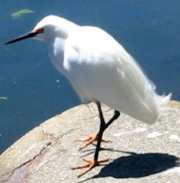
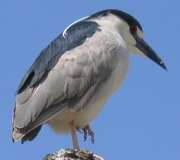
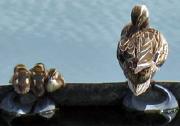
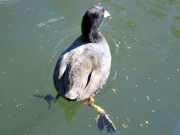
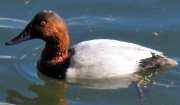




Comments